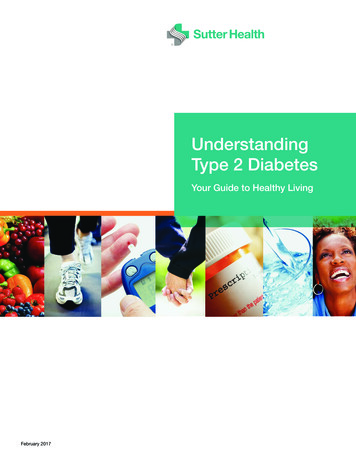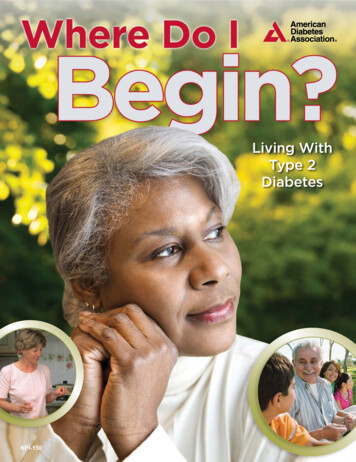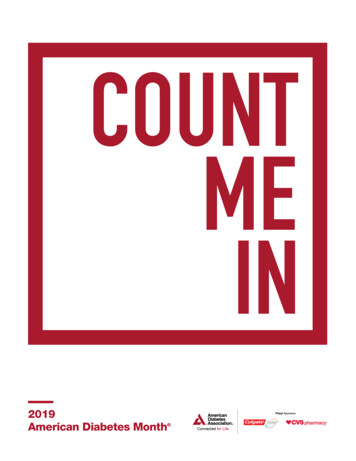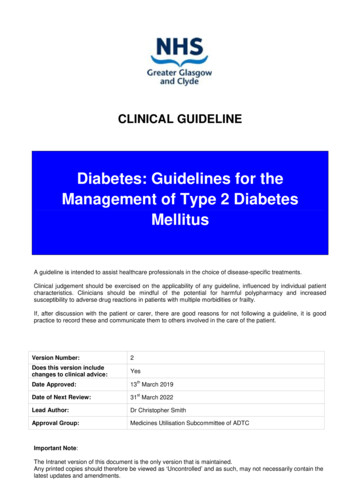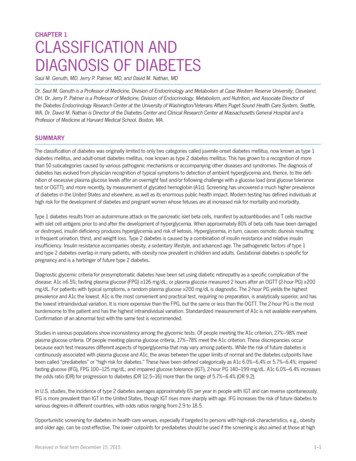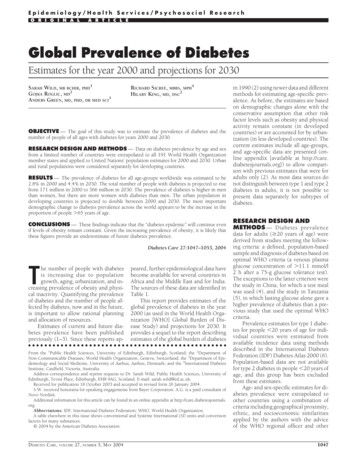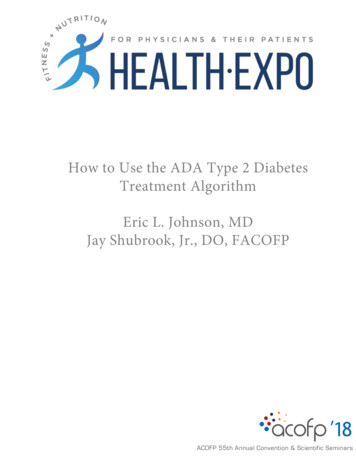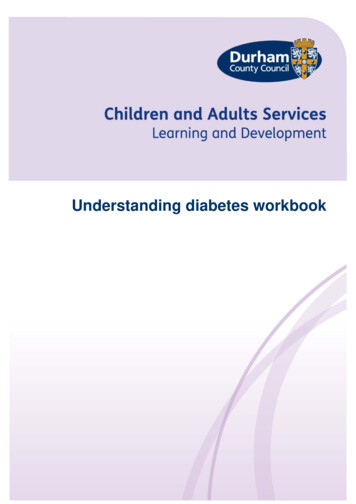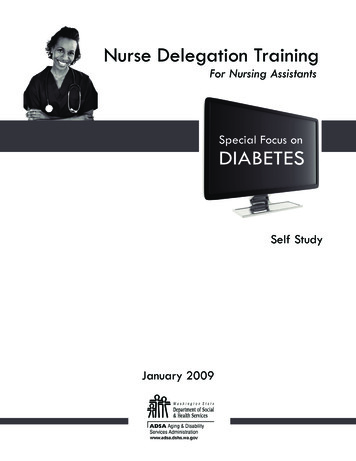
Transcription
Living Well with Diabetes
Table of ContentsLiving well with diabetes. 2What is diabetes?. 3Types of diabetes. 4Type 2 diabetes-insulin resistance. 4Risk factors for type 2 diabetes. 5Warning signs of diabetes. 5Monitoring your blood glucose. 6Monitoring your A1C. 7Hyperglycemia or high blood glucose. 8Hypoglycemia or low blood glucose. 8Healthy eating. 10Taking medications. 15Be active every day. 16Reducing your risk of diabetes complications. 18Foot care. 20Problem solving. 21Coping with diabetes. 22Managing sick days. 23Preparing for your healthcare provider visit. 24You can do this!. 24
Living well with diabetesNearly 30 million adults and children live with diabetes in the United States. If you just found out you’reone of them, you may feel scared or overwhelmed. Even though there is currently no cure, you willdiscover there are steps you can take to manage diabetes. Millions of people with diabetes live full,healthy lives. This book will teach you the basic skills and information to live well with your diabetes.To get started on managing your diabetes, we’ll cover: 3Monitoring your blood glucose and A1CUnderstanding hyperglycemia/hypoglycemiaEating healthierTaking medications (if prescribed)Being activeReducing your risk of diabetes complicationsCaring for your feetSolving problemsLearning healthy coping skillsManaging sick daysCommunicating with your healthcare provider
What is diabetes?Diabetes means your blood glucose or sugar is too high. Glucose is used by your body for energy andcomes from two places: Food (Digestive System) Your liverYour body turns most of the food you eat into GLUCOSE. Glucose is carried by your blood throughoutyour body. When there is glucose in your blood, your pancreas releases insulin. Insulin is a hormonethat acts like a KEY – opening cells and allowing glucose to move from your blood into your cells. Onceglucose is in your cells, it can be used for energy now or stored by the body for use later.HOW BLOOD GLUCOSE IS USED FOR ENERGYLiverDigestive SystemMusclePancreasFat Cells4
Types of diabetesType 1: Although it can happen at any age, most people with type 1 diabetes are diagnosed under the age of 30.Type 1 diabetes is caused when the body’s immune system attacks the cells of the pancreas that make insulin.The treatment for type 1 diabetes includes meal planning, monitoring, physical activity and insulin.Type 2: Ninety to 95 percent of all cases of diabetes are type 2. In this situation, the cells in your body resist theaction of insulin. Insulin is needed to move glucose out of your blood and into your cells for energy. Treatmentfor type 2 diabetes includes meal planning, monitoring, physical activity and, for most, diabetes medications.Gestational Diabetes: This type of diabetes develops during pregnancy. For most women, their blood glucosereturns to normal after delivery. Women who have had gestational diabetes are more likely to develop type 2diabetes later in life.TYPE 2 DIABETES-INSULIN RESISTANCE (Cells are resistant to insulin)LiverDigestive SystemMusclePancreasFat CellsOften, insulin resistance starts many years before it develops into type 2 diabetes. The more resistant your body is,the more insulin your pancreas must make. During the early years with insulin resistance, your pancreas can keepup with the increased need for insulin. Over time, your pancreas-producing ability slows down. As a result, yourblood glucose will rise, resulting in type 2 diabetes.5
Risk factors for type 2 diabetesAmong the risk factors for type 2 diabetes are some you can change or control and others you cannot: Family history of type 2 diabetesBeing overweightOlder than 45 years oldAfrican American, American Indian, Asian American, Pacific Islander or Hispanic American/Latino ethnicityInactivityHigh cholesterolHigh blood pressurePrevious gestational diabetes or had a baby weighing 9 pounds or more at birthStart thinking about the changes you can make to improve your health. Small changes can have big results.For example, losing even 10 to 15 pounds helps reduce your risk of developing type 2 diabetes.Warning signs of diabetesSome people have signs or symptoms of diabetes, while others may not have any symptoms.COMMON SIGNS AND SYMPTOMS OF DIABETESType 2 DiabetesType 1 DiabetesFatigueBlurry visionDry itchy skinCuts or sores that heal slowly or not at allFrequent infectionsNumbness or tingling of the hands or feetExtreme thirstFrequent urinationIncreased hungerWeight loss6
Monitoring your blood glucoseTesting your blood glucose (sugar) is an important part of your diabetes self-care. Daily monitoring will help yousee how food, activity, stress or illness affects your blood glucose. It also provides your healthcare provider vitalinformation on your treatment plan. While testing can be a challenge for some, monitoring on a regular basis iskey to helping you better manage your diabetes.Your target blood glucose should be individualized and based on the recommendations of your healthcareprovider. If you have not discussed your target blood glucose range with your healthcare provider, you will wantto do so. In the meantime, you can use the recommendations from the American Diabetes Association: Fasting or before meal Two hours after start of meal80-130Less than 180Talk with your healthcare provider about how often and when to check your blood glucose.Typical times of the day are: When you first wake upBefore a mealTwo hours after the start of a mealAt bedtimeRecord your blood glucose results in a logbook or download them into your smart phone or computer.Other factors affect your blood glucose so you may want to track them as well: Dose/time when you took your diabetes medicationFoodActivityStressIllnessTo be sure you’re getting the most accurate results when you test your blood glucose: Follow the manufacturer’s recommendations on the care and use of your meter Make sure your skin is clean before checking your blood glucose7
Monitoring your A1CThe A1C test shows the average value of your blood glucose over the last two to three months by measuring theamount of glucose attached to your red blood cells. Since red blood cells live for three months, the test showsthe amount of glucose in your blood during that time. When you have too much glucose in your blood, your A1Cnumber will be higher.You and your healthcare provider will use the A1C test and your daily blood glucose tests to assess whether yourdiabetes treatment plan is working.Normal A1CHigh A1CBlood VesselHigh A1C levels increase your risk for problems caused by diabetes.For each point decrease in your A1C, you can reduce your risk oflong-term complications of diabetes by up to 40 u can lower your A1C by keeping your daily blood glucosein your target range.32613%29812%The chart shows how your A1C equals your blood glucosenumbers on your meter.26911%24010%In general, your A1C will be checked at least twice a year.If you are not on target, more frequent testing may be needed.2129%1838%Talk to your healthcare provider to find out what he or sherecommends as your target A1C. Although the AmericanDiabetes Association recommends a target A1C of 7 percentor less, A1C targets are often specific to an individual.1547%1266%My target A1C goal is8
Hyperglycemia or high blood glucoseAlthough your blood glucose levels will vary throughout the day and night, one goal of your diabetes treatment planis to keep your blood glucose on target as often as possible.What can make your blood glucose too high? Eating too much food Less activity than usual Forgetting to take or taking too little diabetes medication Infection, fever or illness Changes in hormone levels such as during menstrual periods Stress Some medications such as steroidsSigns of high blood glucose Feeling thirsty Going to the bathroom more than usual – especially at night Feeling tired Blurry visionWhat should you do if you suspect your blood glucose is too high? Check your blood glucose – report any pattern of high blood glucose to your healthcare provider Take diabetes medications as directed – if you cannot afford your medication, tell your healthcare provider Follow your meal and exercise plans Drink plenty of “no carbohydrate” drinks – water is the best choiceHypoglycemia or low blood glucoseWhen your blood glucose is too low, your body is not receiving the fuel you need to stay healthy. Your brain may notbe getting enough glucose to work properly. You will need to be able to recognize the signs of low blood sugar soyou can treat it quickly.What can cause your blood glucose to go too low? Delaying or missing a meal Eating too little Too much activity Taking too much diabetes medication Drinking alcohol without eating9
Signs of low blood glucose Feeling dizzy, light-headed or shaky Sweaty or clammy skin Fast heart beat Hunger Confusion, headache or irritability Unable to be awakenedWhat should you do if you’re feeling the signs of low blood glucose? If possible, check your blood glucose– if less than 70 or if you cannot test, eat or drink 15 grams of carbohydrate– if less than 50, eat or drink 30 grams of carbohydrate Wait 15 minutes and recheck– if still less than 70, eat or drink 15 grams of carbohydrate– if greater than 70 and more than 1 hour before next meal, consider eating 1 ounce protein(example: one piece of string cheese) Wait another 15 minutes and recheck– if still less than 70, eat or drink 15 grams of carbohydrate– if your glucose remains less than 70 after three treatments, consider calling for assistance or 911Good choices for treating low blood glucose (emergency foods) 4 glucose tablets ½ cup or 4 ounces of fruit juice or soft drink (not diet) 1 cup or 8 ounces of skim or 1% milk 1 tablespoon of honeyPotentially life-saving tips Always wear identification stating that you have diabetes.That way, if you pass out, others will be able to help you Always carry emergency foods (listed above) with you Test your blood glucose more often– on days you exercise– when you are ill– any time you change your diabetes treatment plan10
Healthy eatingYou can still enjoy your favorite foods and eating out, even though you have diabetes. In fact, there is nostrict diabetes diet. A healthy meal plan is about eating the right portions and combinations of foods, withthe goal of reducing your risk of diabetes complications.When to eat Eat at least three times a day Space meals four to six hours apart Try to eat at about the same time every day Try not to skip mealsWhat to eat A wide variety of foods Decrease portions of carbohydrate foods Limit foods high in saturated fat and sodium (salt) Eliminate high-sugar drinksUnderstanding carbohydratesCarbohydrates are foods that rapidly convert into glucose. That means, they can raise your blood glucosevery quickly. Controlling the number of carbohydrates in each meal will help you maintain a healthierblood glucose. If you eat too many carbohydrates, your blood glucose will rise more than it should.However, eliminating all carbohydrates from your diet is not the answer. Your body needs carbohydratesfor energy and normal healthy functioning.Foods that are very high in carbohydrates Breads, crackers, cereals, pasta and rice Starchy vegetables such as potatoes, corn and peas Beans and lentils Fruits and fruit juices Milk and yogurt Combination foods like casseroles and pizza Sweets like cookies, pies and candy11
Plate methodThe plate method is an easy way to help you plan your meals:Use a 9-inch plateFill half with non-starchy vegetablesFill one-quarter with a lean meat or other proteinFill one-quarter with a bread, starch or whole-grain carbohydrate (15 grams carbohydrate)Add a small piece of fruit (15 grams carbohydrate)8 ounces of skim or 1% milk (15 grams carbohydrate)This meal plan has 3 choices or 45 grams of carbohydrate.On average, food plans include three to four carbohydrate choices per meal. One carbohydrate choice equals15 grams of carbohydrate. You may need more or less, depending on your personal goals. Include at least twocarbohydrate choices at each meal to help assure good nutrition.GENERAL CARBOHYDRATE GUIDELINES FOR EACH MEALTo Lose WeightTo Maintain WeightFor the Very ActiveWomen2-3 choices(30 to 45 grams)3-4 choices(45 to 60 grams)4-5 choices(60 to 75 grams)Men3-4 choices(45 to 60 grams)4-5 choices(60 to 75 grams)4-6 choices(60 to 90 grams)12
Food labelsKnowing how to understand nutrition labels can help you makebetter food choices. Food labels have a wealth of informationthat will be valuable to you.In this example, the serving size is 1 cup, and has 31 grams ofcarbohydrate (equal to two carbohydrate choices). You’ll wantto always look first at the total carbohydrates – because thisis the number that raises your blood glucose. Sugar grams areincluded in the total carbohydrate number.Serving sizesWhen you first try to estimate the size of a serving, it may be difficult. Begin by measuring your drinksand foods, do this periodically to keep your estimates more accurate. You can use your hand as a guide: ½ cup is about the size and thickness of the palm of your hand 1 cup is about the size of your fist 1 bread serving is about the size of your open palm and half of your fingers 1 tablespoon is about the size of your thumbHELPING HANDS1/2 cup is about the sizeand thickness of yourpalm without the fingers(examples: peas, corn)131 cup is about the size ofyour fist (examples: milk,soup, squash)1 snack choice is amoderate handful(examples: chips,pretzels)1 bread choice is aboutthe size of your openpalm and half yourfingers (examples:chips, pretzels)
Sample meal planBreakfast 1 egg 1 slice whole wheat toast 1 carbohydrate choice or 15 gramsof carbohydrate 1 teaspoon butter made with olive oil spread 1 small orange 1 carbohydrate choice or 15 grams ofcarbohydrate 1 – 6 ounce lite yogurt 1 carbohydrate choice or 15 grams ofcarbohydrate Sugar-free beverageLunch 1 turkey wrap with lettuce, tomato & mustard 1 carbohydratechoice or 15 grams of carbohydrate 1 cup side salad with 1 tablespoon of lite vinaigrette 8 baked potato chips 1 carbohydrate choice or 15 grams ofcarbohydrate 1 small apple 1 carbohydrate choice or 15 grams ofcarbohydrate Sugar-free beverageDinner 3 ounces grilled pork loin chop or chicken breast ½ cup mashed potatoes 1 carbohydrate choice or 15 gramsof carbohydrate ½ cup lite canned peaches 1 carbohydrate choice or 15grams of carbohydrate ½ cup green beans 2 small cookies 1 carbohydrate choice or 15 grams ofcarbohydrate Sugar-free beverageSnack, if desired 3 cups light popcorn 1 carbohydrate choice or 15 grams ofcarbohydrate 1 string cheese14
Controlling your carbohydrates is one aspect of healthy meal planning. You’ll alsowant to choose foods low in saturated fat and salt (sodium) to help manage yourcholesterol and blood pressure. A diabetes educator or registered dietitian canhelp you with meal planning. Here are some suggestions:HEALTHY FOOD SUBSTITUTES15FoodInstead of.TryGrainsWhite bread, white rice, frenchfries, macaroni and cheese,biscuits, rollsWhole-grain bread, whole-grain pasta,brown rice, baked potato, beans and lentilsFruitFruit juices, fruit snacks, fruitcanned in heavy syrupFresh fruit, frozen fruit, fruits canned intheir own juiceMilkWhole milk, 2% milk, full-fat yogurtSkim milk, 1% milk, light soy milk, fat-freeand artificially sweetened yogurt andpuddingCombination FoodsThick-crust supreme pizza, chiliwith beef, lasagna with sausageand cheeseThin-crust veggie pizza, chili with turkey,lasagna with chicken and low-fat cheeseNon-StarchyVegetablesCanned vegetables, fried vegetablesFresh vegetables, frozen vegetables,steamed/ baked vegetablesMeatsFried meats, sausage, bologna,baconBaked/grilled meats, turkey, chicken, fishFatsButter, mayonnaise, sour cream,bacon fat, creamy salad dressingsOlive oil-based products, canola oil, lightsour cream
Taking medicationsMany people with diabetes may need to take medicine to keep their blood glucose on target.Each diabetes medication works in a different way. For example, your medicine May help your cells to be less insulin resistant May help your body release more insulin or May help your body use its own insulin more effectivelyFrequently, multiple medications are needed.Depending on your overall health, your healthcare provider may also prescribe medication tohelp manage your blood pressure or cholesterol. Taken along with your diabetes medications,these medications may be critical in helping delay or prevent complications of diabetes.Make sure you understand The name of the medicine and the correct dosage When to take your medicine(s) What to do if you forget to take your medicine(s) Possible side effects How to take medication safely if you use alcoholHelpful tips Take your medicines as prescribed Use a pill reminder box Set alarms on your phone Place sticky notes in places that you will notice them Set up automatic refills at your pharmacy Keep a current list of all medications with you Report any side effects or problems to your healthcare provider If you cannot afford your medication, tell your healthcare provider16
Be active every dayGetting regular physical activity can help you live a healthier life. Being active helps: Lower your blood glucose levelsYour body use insulin more effectivelyYou lose weight and keep it offLower your blood pressureLower your blood fats, like cholesterol and triglyceridesLower your stress levelsIncrease your strength, endurance and flexibilityThe American Diabetes Association recommends 150 minutes of exercise or activity each week. Speak withyour healthcare provider on your personal goal for exercise. If you have not been active, start slowly with fiveto 10 minutes twice daily and work up to your goal.If you are having difficulty finding the time or motivation to start exercising, keep in mind that three 10-minutesessions in a day is as good as one 30-minute session. Choose activities you enjoy, such as walking, biking,armchair exercise, or attending exercise classes. When you choose something you enjoy, you are more likelyto make it a regular part of your life.Try turning everyday activities into exercise opportunities. Take the stairs instead of the elevator, walk aroundwhile you talk on the telephone or march in place while watching TV.More vigorous activities like brisk walking, dancing, swimming or riding a bicycle will help strengthen yourheart and lungs. If you sit for long periods of time, make sure you get up and move every 90 minutes.Increase your strength by using resistance bands, weightlifting (hand weights or machines) or exercising withlight weights like canned goods or bottles of water at home. This helps build muscle, aids in weight loss andimproves bone density.Stretching before you exercise will improve your flexibility and help prevent injury.17
When you are increasing your activity level, be sure to test your blood glucose more frequently, especiallyif you are on insulin or taking medication(s) to lower your blood glucose. Your blood glucose should be greater than 100 before you exercise Check your blood glucose after you exercise and record it. Take these readings to your healthcareprovider to help decide if any changes are needed in your treatment plan. Be alert to possible low blood glucose after you exerciseDiscuss your exercise plan with your healthcare provider or diabetes educator.Helpful tips Choose comfortable clothing that fits properly, especially your shoes Wear identification that says you have diabetes Always drink more water or calorie-free beverages when you exercise, especially in warm weather.Don’t wait until you are thirsty to begin drinking. Carry an emergency food that contains carbohydrate (See the list of carbohydrates in the HealthyEating chapter) in case your blood glucose drops low If you have numbness or loss of feeling in your feet or legs, you may want to choose exercise that putsless strain on your feet, such as biking or swimming18
Reducing your risk of diabetes complicationsIt is natural for diabetes to change over time. These changes happen at different times for each person.Your body may become more resistant to the action of insulin. Over time, your pancreas may produce lessinsulin. Because of the possibility of these changes, your treatment plan may need to be adjusted.See your healthcare provider two to four times a year to determine your diabetes control.Your healthcare provider will also check to be sure you are not developing any complications of diabetes.Catching these early can be critical to prevention and managing them.COMPLICATIONS OF DIABETESEyes(retinopathy)Brain(stroke)Heart(heart al dysfunction)Legs & Feet(PAD)Peripheral ArterialDiseaseNerves(neuropathy)19
Heart problems or stroke – damage to the large blood vessels can lead to heart attack or stroke Eye problems – damage to the small blood vessels of the eye can lead to vision problems.High blood pressure can worsen eye disease. Tooth and gum problems – high blood glucose can increase your risk for gum disease Feet – damage to small and large blood vessels can slow circulation and damage the nerves in thelegs and feet. Decreases in circulation and nerve response can lead to delays in wound healing andreduce walking stability. If wounds don’t heal, then amputation may result. Kidneys – damage to the blood vessels in the kidneys can cause a decrease in kidney function Sexual function for both men and women – nerve damage can interfere with the body’s sexualresponse and function Nerve problems (neuropathy) – can occur in all parts of the bodyOne of the most effective ways to delay or prevent these complications is to keep your blood glucoseas close to your target goal as possible. If you have other health conditions, such as high bloodpressure or abnormal cholesterol, your risk for developing diabetes complications is even higher.Working with your healthcare provider to manage all your health conditions is the best way to protectyour health.Helpful tips Don’t rely on your healthcare team to identify areas of concern. No one has more at stake than you do.Play an active role in reducing your risk. Learn about complications and how to delay or prevent them Talk with your healthcare provider about the tests you need. Maintain your own personal care record. Reduce your risk of complications by taking these precautions:– Don’t smoke– Schedule regular medical checkups– Follow your healthcare provider’s recommendations on other tests you should have– Keep your feet dry and clean. Look for redness or sores, and report these to yourhealthcare provider if you find them– Listen to your body and recognize when you aren’t feeling well, and call your healthcare provider20
Foot careTaking care of your feet every day can help prevent diabetes-related foot problems.Best Practices21Clean Check feet daily Use your hands to feel your feet. A spot that feels hot to the touch can be asign of infection. Look at the top and bottom of each foot and between the toes. Check for any cuts,cracks, sores, redness or swelling. Call your healthcare provider if have a cut or scrape that is slow to heal, itches,feels warm, oozes fluid or smells bad. Use a mirror or ask for help if you have difficulty checking your feet.Protect Treat Apply lotion to dry feet, but not between your toes as this can lead tofungal infections. Do not use sharp instruments, chemical treatments or abrasive materials on corns,calluses, or ingrown toenails. Let your healthcare provider help treat these. Clean and treat minor cuts or sores. Contact your healthcare provider if theyare not healing.Healthcare providerfoot check Remove your shoes and socks at every diabetes visit to remind yourhealthcare provider to check your feet. Report foot problems immediately to your healthcare provider.Wash your feet daily with mild soap and warm water.Do not soak your feet. Soaking can cause dry skin that cracks easily.Dry feet well, especially between the toes.Trim nails straight across. Let your healthcare provider know if you are unableto trim your nails.Do not walk without protecting your feet with slippers or shoes.Wear well-fitting socks and shoes.Check your shoes before you put them on to be sure there are no objects inside.When bathing, check the water temperature with your hand first.
Problem solvingAt one time or another, almost everyone encounters problems trying to control their diabetes.Challenges like low or high blood glucose will happen. In the long run, the more you understandabout why a problem occurred, the better you’ll be able to prevent it from recurring.Developing good problem-solving skills takes practice. By following a few key steps, you can learnhow to work your way through a difficult situation. Remember, if your first solution doesn’t work, youcan always try another idea. Be willing to accept that the problem may not be solvable right now.You can always revisit it later.1. Don’t beat yourself up. Managing your diabetes doesn’t mean being perfect.2. Think about your daya. Was your day stressful?b. Were you feeling ill?c. Was your routine different – woke up earlier, went to bed later or something else?d. Were you less active than usual?e. Were your meals larger than usual?3. After reviewing your day, did you find a possible reason for your high blood glucose?4. If so, what changes can you make now to help prevent a high blood glucose reading next time?Keep in mind that keeping your blood glucose on target is the best way to manage your diabetes anddelay or prevent complications. If at least half of your blood glucose readings are on target, there isa good chance that your A1C will be on target as well.– Review your dayIdentify Problem(High Blood Glucose)– Choose how to correct problem– Put this plan into action– Learn from experience22
Coping with diabetesLiving with diabetes every day can be discouraging, stressful or even depressing. How you deal withthese emotions can affect your health. You may have mixed feelings about diabetes: that’s natural.Discover positive techniques for handling the difficult emotions that come with having diabetes.Healthy ways to cope include having enjoyable hobbies, joining a support group, exercising,journaling or practicing meditation. Having the support of family, friends and other people withdiabetes (support group) can help you feel less alone in coping with diabetes.Helpful tips Simplify and organize your daily life Plan ahead to help manage a busy schedule Try deep breathing exercises, meditation or prayer to help relax Exercise regularly Talk with a friend or family member Get adequate sleep and rest Be patient. Making changes in your lifestyle takes time and practice. Aim for consistency, not perfectionSometimes emotional lows can be lengthy and negativelyimpact your overall health. This can be a sign of depression.Talk with your healthcare provider if you have experiencedany of these symptoms on a long-term basis: Difficulty sleeping Poor appetite Not seeing the benefit of taking care of yourself Decreased interest or pleasure in your life Withdrawing from others Feeling like diabetes has taken over your life23
Managing sick daysPay special attention to your diabetes when you are ill. Illness can cause your blood glucose to risequickly. Therefore, you will need to test your blood glucose more often when you are ill. High bloodglucose readings can be be a sign of infection and can also cause an infection to get worse.Helpful tips Take your regular diabetes medications at the usual time Check your blood glucose more often than usual Drink extra fluids such as water, broth or caffeine-
5 Types of diabetes Type 1: Although it can happen at any age, most people with type 1 diabetes are diagnosed under the age of 30. Type 1 diabetes is caused when the body’s immune system attacks the cells of the pancreas that make insulin. The treatment for type 1 diabetes includes

